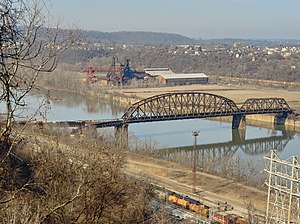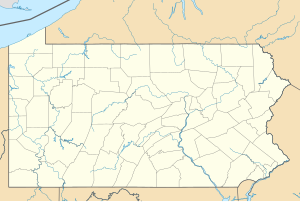Union RR Carrie Furnace Hot Metal Bridge
Coordinates: 40 ° 24 ′ 30 ″ N , 79 ° 53 ′ 9 ″ W.
| Union RR Carrie Furnace Hot Metal Bridge |
||
|---|---|---|
| The bridge with the last two blast furnaces (2020) | ||
| use | Railway bridge, 2-track | |
| Convicted | Union Railroad | |
| Crossing of | Monongahela River | |
| place | Whitaker - Rankin | |
| construction | Steel truss bridge | |
| overall length | ~ 805 m | |
| Longest span | 147 m | |
| Clear height | 15.5 m | |
| opening | December 31, 1900 | |
| planner | Keystone Bridge Works | |
| closure | before 1980 | |
| location | ||
|
|
||
The Union RR Carrie Furnace Hot Metal Bridge is a former double-track railroad bridge that spans the Monongahela River near Pittsburgh . The Union Railroad (RR Union, URR) transported from 1900 to the 1970s, liquid pig iron ( English hot metal ) by Carrie Furnaces in the steel plant Homestead Steel Works .
history
Andrew Carnegie bought the Carrie Furnaces blast furnaces in 1898 . In June 1898, the Union Railroad's Port Perry Bridge was available to him for rail transport across the Monongahela. For the direct connection of the blast furnaces to his steelworks in Homestead , he commissioned the Keystone Bridge Works to build the Hot Metal Bridge. On December 31, 1900, the first train with pig iron crossed the bridge. The ladle cars each transported 35 tons of liquid iron. The Union Railroad was also part of Carnegie's company. On June 14, 1901, the bridge was opened to general traffic.
Carnegie sold the Carnegie Steel Company with blast furnaces, the steel mill in Homestead and the Union Railroad to US Steel in 1901 . The Carrie Furnaces were expanded to seven blast furnaces in 1907. Blast furnaces 6 and 7 have been listed since 1989 and have been part of the Rivers of Steel National Heritage Area since 1997 , which also acquired the bridge. In 2013 the approach bridge was dismantled. The Allegheny County Economic Development has 38.5 hectares of area investors, of which 8.5 hectares are located on the South Shore. The bridge could be converted into an additional connection to road traffic.
description
The bridge leads from Whitaker on the south side of the river to Rankin. The area on the north side belonged to the Carrie Furnaces. The approximately 530 meter long foreland bridge ended in an arch on the factory premises. The bridge was more than 800 meters long and consisted of two steel truss bridges with an underlying carriageway and two edge fields without trusses over the 280 meter wide Monongahela River . The latter lead the tracks in curves to the west and east. The main field with the shipping opening is designed as an arch bridge. Their span is 147 meters. The first field on the north side is laid out as a box-shaped truss and has a span of around 76 meters. The structure was designed for two tracks. The trains with pig iron only ran on the western track. The construction was shielded from the heat radiation of the ladle car with steel plates .
Web links
- pghbridges.com: URR Carrie Furnace Hot Metal Bridge. (English)
Footnotes
- ↑ plaque on the bridge; see. commons.wikimedia.org: MAKER 'S PLATE (OF KEYSTONE BRIDGE WORKS) (photography from 1989)
- ^ Bob Downing: Rust, grit mark Pittsburgh's historic and colorful Carrie Furnaces that produced iron for steel making. In: beaconjournal.com. May 25, 2013, accessed July 2, 2020 .
- ↑ a b Bruce S. Cridlebaugh: URR Carrie Furnace Hot Metal Bridge. In: pghbridges.com. Retrieved July 23, 2020 .
- ↑ Historic Landmark Plaques 1968–2009. Pittsburgh History & Landmarks Foundation, accessed June 14, 2020 . (PDF file)
- ^ Carrie Furnace Redevelopment. In: carriefurnacesite.com. Retrieved July 2, 2020 .
- ↑ All dimensions according to the drawing by Bruce S. Cridlebaugh in pghbridges.com .


